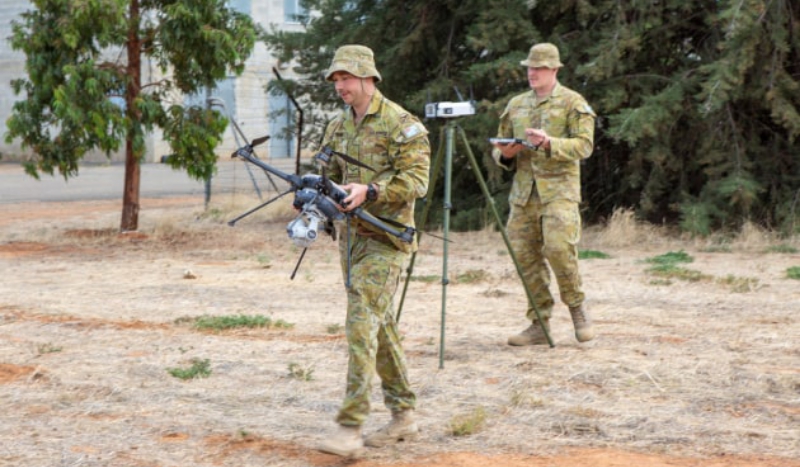A first-of-its kind trial to remotely pilot a small Unmanned Aerial System (UAS) from the back of a C-130J has the potential to open up a range of capability options for the joint force. The effort was a collaboration between Plan Jericho, 3SECFOR, 37 Squadron and Army.
The trial, recently undertaken at RAAF Edinburgh, tested the viability of operating a UAS via the aircraft’s onboard Satellite Communications (SATCOM) link. This has opened up future potential to operate UAS, or other networked capabilities, from anywhere in the world and, vice versa, demonstrating an ability to upload live imagery from off-board sensor systems.

No. 3 Security Forces Squadron Leading Aircraftman Rhys Mitting (left) and Chaddyn Bray prepare the drone for operation from an airborne C-130J Hercules
Squadron Leader Peter Cunningham highlighted that this trial was the first time that airborne control UAS has been attempted from a C-130J Hercules.
This trial was the first time that airborne control UAS has been attempted from a C-130J Hercules.
“We used our wide-band SATCOM systems to provide a link to the UAS controller on the C-130J beyond the line of sight, and received video from the UAS throughout the flight,” SQNLDR Cunningham said.
Using 3SECFOR’s UAS capability together with the Air Mobility Innovation C-130J aircraft, enabled the team to conduct the trial within a very short timeframe.
“Working together with different skill-sets and stakeholders such as 3SECFOR, Army and Plan Jericho has shown how we can be responsive to meet the needs of Air Force in pretty short order,” SQNLDR Cunningham said.
Corporal Mitchell Blight sees enormous potential for Army Commanders on the ground.
“With this sort of technology, we can see much further and be more distant from our targets, while still getting a comprehensive understanding of the ground in front of us through a streamlined information feed,” CPL Blight said.
“While this is still in the proof of concept phase, we were very pleased to see how rapidly the team were able to get the unclassified concept off the ground in just two weeks,” Plan Jericho’s Advanced Sensors lead, Wing Commander Paul Hay said.
During the airborne operation, the team were also able to capture overarching video of the trial, using the Litening sensor pod, which was recently mounted on a pylon underneath the wing of the C-130J demonstrator.
This proof of concept further extends the connected sensor network.
Sources: Royal Australian Air Force; Australian Defence Magazine

just to be clear, they where controlling drones from bombers in WWII, just putting my head around the costs to make a 2o min drone flight a reality… everything has to have a starting point.